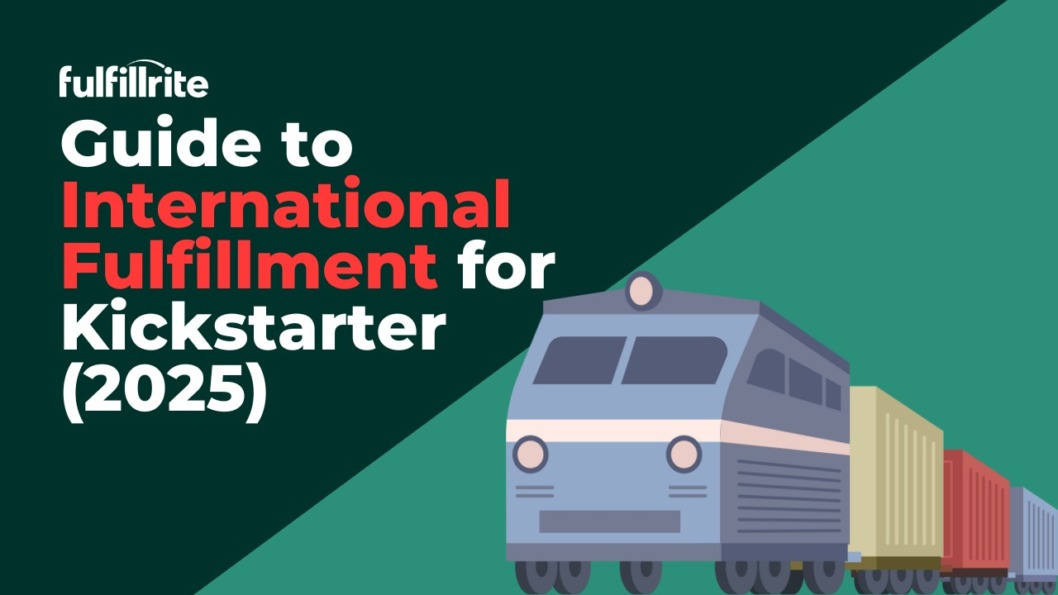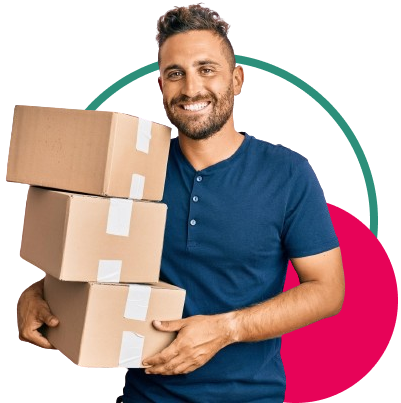If you’re planning a global Kickstarter, you probably already know that international fulfillment is complicated. It’s no overstatement to say it can quickly become the most complex part of your campaign.
I sat in on a panel at GAMA 2025 called International Fulfillment and Logistics, featuring experienced partners from across the world: Matt Goldrick (Quartermaster Logistics, USA), Chris Matthews (ZATU, UK), Floris Toorenberg (Meeples Group, EU), and Paul Johnson (Aetherworks, Australia & New Zealand).
Together, they broke down what creators need to know about shipping products to backers in different regions, including tax registration, customs, biosecurity, and the paperwork that can make or break your campaign.
This post contains 8 of my favorite takeaways from that panel. Here, you’ll find practical advice drawn from years of experience handling Kickstarter campaigns large and small.
If you’re new to international fulfillment for Kickstarter, or just want to avoid costly mistakes, this is a great place to start.
1. You might end up working with multiple order fulfillment companies.
If you’re shipping a Kickstarter campaign worldwide, don’t expect a single fulfillment partner to handle everything. As Matt Goldrick from Quartermaster Logistics (QML) explained, even large, experienced U.S. companies outsource international fulfillment.
QML doesn’t handle UK, EU, or Australian fulfillment directly — instead, they rely on trusted regional partners: ZATU (UK), Meeples Group (EU), and Aetherworks (Australia and New Zealand). At Fulfillrite, we operate the same way, sometimes even sharing our clients with some of the companies mentioned in this post.
Each region has unique rules, import processes, and tax requirements. For example, what’s legal and simple in Australia might be a bureaucratic nightmare in the EU. Even two countries in Europe may require different paperwork. “It’s not just the EU,” said Floris from Meeples Group. “Norway and Switzerland aren’t part of it. You’ll need to know the difference or you’ll get double-taxed.”
Trying to manage each region on your own is technically possible, but time-consuming and risky. “You can work with all of us individually,” said Matt, “but then you’re managing four sets of taxes, four sets of paperwork.”
For most creators, it’s smarter to work with a central partner who coordinates across trusted local experts. These teams know the terrain — literally and figuratively — and can save you from expensive mistakes.
2. The UK has unique rules. If you ship there, you need someone who knows them.
Shipping within the UK is fast, reliable, and relatively inexpensive. As Chris Matthews from ZATU put it, “You can ship around the UK in one to two days max. Couriers are fairly reliable, and there’s no volumetric pricing — only actual weight matters.” You can even use large letter sizing for small items like spare parts or mini-expansions, which keeps postage costs low.
But creators still run into trouble. Why? “Speed issues are usually from lack of preparation,” Chris explained. “If your fulfillment partner doesn’t have your product data or SKU list in advance, things fall apart.” He also warned that some UK partners are slow to adopt new tech. “Ask them what tools they use. Can you see live updates? Do they have service-level agreements?”
Import rules are another sticking point. “Do not use your fulfillment partner as the importer of record,” Chris stressed. “It’s illegal.” You must register for a UK VAT number and an EORI number — even if you’re only selling one game. Both are easy to get, or you can hire a VAT agent to handle it for you.
Lastly, don’t reuse barcodes across different language versions of your game. “Same barcode on the English, German, and French versions? That’s a recipe for mistakes.”
3. The European Union has even more complex rules than the UK.
Shipping into the EU comes with a whole new set of challenges. As Floris from Meeples Group explained, many creators mistakenly assume the EU and UK work the same way — but they don’t. “The UK is not the EU. Norway and Switzerland aren’t either. They all have different rules, and if you don’t understand that, you’ll pay double tax or get stopped at customs.”
Like the UK, selling in the EU requires a VAT number and an EORI number. The EORI application is simple — just a 10-minute online form. You’ll also need to appoint a GPSR representative, which is essentially a local point of contact in case there’s a product issue. “It’s not about who’s at fault,” Floris clarified. “It’s about who can be reached in Europe if something goes wrong.”
Another key point: barcode hygiene. Make sure every SKU has a unique barcode — and don’t reuse the same code across language editions or product variants. Fulfillment centers need to identify items clearly and quickly.
Above all, zoom out. “Think about the big picture,” said Floris. “What’s your post-campaign strategy? Retail? DTC? Your fulfillment plan should support that long-term model, not just ship a few boxes.”
4. Australia & New Zealand: easy to ship in terms of tax, tough in terms of biosecurity.
Shipping to Australia and New Zealand is more straightforward than most people think — at least on the tax side. “You don’t need to register for VAT in Australia unless you’re doing over $100,000 AUD in sales,” said Paul Johnson of Aetherworks. “We can act as the importer of record and settle the GST on your behalf.” That alone simplifies the process for most Kickstarter creators.
But what Australia lacks in tax red tape, it makes up for in strict biosecurity. “Between September and April, anything coming from the Northern Hemisphere may need to be fumigated,” Paul said. “Books and games are low-risk, but it still helps to pre-treat the container.”
Creators must also include a timber declaration — pallets must be heat-treated or plastic. If not, the shipment can be held at port, and you’ll start paying demurrage fees: hundreds of dollars per day while customs sits on your container.
Other watchouts: lithium batteries, aerosols, and other “dangerous goods” are expensive to ship and best avoided.
And don’t forget geography. “Australia is big,” Paul warned. “Getting something from Sydney to Perth is like going from New York to San Francisco. Plan accordingly.”
5. Paperwork is the real work.
Shipping games internationally isn’t just about packing boxes—it’s about paperwork. All four panelists made it clear: documentation is what actually moves product through customs. “I’ve got great people in the warehouse to put tape on boxes,” said Paul Johnson from Aetherworks. “That’s not the hard part. This is the hard part.”
Every shipment should include a commercial invoice—not based on your retail price, but the cost of manufacture. Customs wants to know what the goods are actually worth, not what you’re selling them for. You’ll also need a packing declaration that details what’s inside each box and how many units.
If you’re manufacturing in China and shipping to Australia, a Certificate of Origin can help you take advantage of trade agreements like CHAFTA (China–Australia Free Trade Agreement), which can waive duties.
Beyond that, you’ll need the proper registrations: VAT numbers for the UK and EU, EORI numbers for importing, and a GPSR representative for Europe. Don’t forget scannable barcodes, either. “You don’t need a UPC unless you’re going into retail,” said Matt Goldrick. “But you do need a unique barcode that matches what’s in the system. That’s how pickers know what to pack.”
6. Avoiding common mistakes is half the battle.
Plenty of crowdfunding creators learn these lessons the hard way. The panelists shared a long list of common pitfalls that can derail fulfillment—or worse, cause customs to hold your shipment and charge you thousands in fees.
One of the biggest? Waiting too long to set up paperwork. VAT registration, EORI numbers, and GPSR reps all take time. “We’ve all had the Hail Mary container,” said Matt. “A call out of nowhere, saying ‘I think I shipped you a container six weeks ago—can you help?’ That’s when it’s too late.”
Another major issue is barcode confusion. “People put the same barcode on the English, German, and French versions,” said Chris from ZATU. “Then the warehouse can’t tell them apart.” That leads to mix-ups, delays, and angry backers.
Failing to plan for damage and overage is another risk. Paul from Aetherworks recommends always sending at least 5% extra stock. “Sometimes a forklift goes through the middle of a pallet. It happens. Better to be ready.”
And while some creators try to manage multiple fulfillment centers themselves, the overhead quickly adds up. Without a coordinator like QML or Fulfillrite, you’ll spend more time tracking tax filings than running your business.
7. You probably shouldn’t do DIY VAT registration.
You can register for VAT yourself—but should you? That depends on your time, comfort with bureaucracy, and risk tolerance.
In the UK and EU, VAT registration is legally required to sell to customers in those regions. “It doesn’t matter if you sell one game or a thousand,” Chris said. “If you don’t have a VAT number, it’s illegal.” You’ll also need an EORI number to import goods and a GPSR representative in the EU.
VAT registration is free if you do it yourself, and the process usually involves filling out a few forms online. But it’s easy to make mistakes. Some creators hire VAT agents to handle registration and quarterly filings for a flat fee—Chris mentioned his company charges around £400 for registration.
“It’s not that hard, but there’s a time cost,” said Floris. “If you like handling logistics and forms, go for it. But if your strength is creative work, it’s worth paying someone to do it right.”
A good fulfillment partner may even include EORI assistance as part of their onboarding process. Either way, get started early so your paperwork is ready before your games hit port.
8. Know when to consolidate and when to segment freight.
If you’re running a smaller campaign, you might assume international fulfillment is out of reach. Not true. The panelists emphasized that networks like Quartermaster Logistics can help creators of all sizes take advantage of consolidated shipping and regional fulfillment.
Paul Johnson explained that Aetherworks is part of Australia’s Trusted Traders Program, which allows them to consolidate goods from multiple creators into a single pallet. “I can have 10, 20, even 30 suppliers on one consolidated run,” he said. That way, you don’t have to ship a full container on your own just to reach Australian backers affordably.
This same principle applies in the EU and UK, where partners like Meeples Group and ZATU can integrate smaller shipments into broader fulfillment pipelines.
Of course, some campaigns are big enough to ship directly to each region. But if you’re under that threshold, the smarter move may be to work with a central partner like QML who routes inventory to regional experts.
“Find a company that can build your infrastructure,” said Floris. “It doesn’t matter if you’re sending 1,000 games or three per month. The network is already there—you just need to plug in.”
Final Thoughts
Kickstarter fulfillment doesn’t mean you have to become a freight expert or tax consultant. It does mean you need the right partners and a plan that goes beyond your campaign’s delivery date.
What stood out most from this panel wasn’t the complexity—it was the clarity these experts offered. The systems are in place. The networks are built. The biggest risk isn’t ignorance—it’s silence. Start conversations early. Ask questions. Double-check your assumptions.
You can’t eliminate every surprise, but you can avoid most disasters by treating fulfillment like the business function it is. That’s not glamorous, but it’s how campaigns turn into companies—and how creators stay in the game long after the first project ships.

